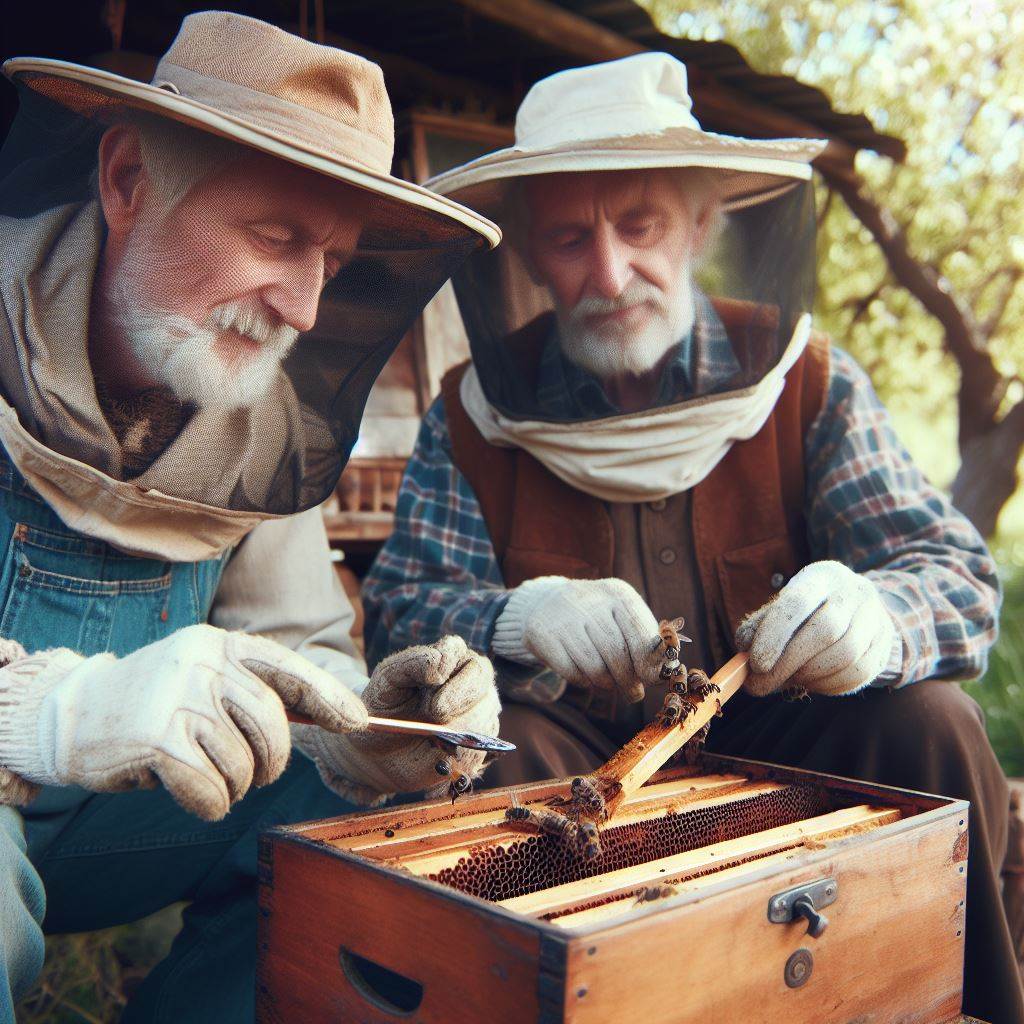Introduction
Beekeeping is a vital part of farming. Bees pollinate crops, ensuring abundant harvests.
They also produce honey, a valuable product. Beekeeping doesn’t have to break the bank.
With resourcefulness and creativity, anyone can start beekeeping inexpensively.
This section will explore practical tips and techniques for beekeeping on a budget.
We’ll discuss sourcing affordable equipment, such as homemade hives or second-hand gear.
Additionally, we’ll delve into cost-effective ways to acquire bees, including catching swarms or buying from local beekeepers.
Managing expenses while maintaining healthy hives requires careful planning and diligent care.
We’ll share strategies for minimizing costs without compromising the well-being of the bees.
From DIY hive construction to utilizing natural remedies for hive health, there are numerous ways to cut expenses in beekeeping.
Whether you’re a seasoned farmer or a novice enthusiast, beekeeping on a budget is achievable.
By prioritizing efficiency and ingenuity, beekeepers can thrive economically while supporting biodiversity and enjoying the fruits of their labor.
Join us on this journey to discover the art of beekeeping without breaking the bank.
Planning and Preparation
The purpose and goals of beekeeping on a budget
- Define the reasons for engaging in beekeeping and set specific goals.
- Consider whether the main focus is honey production, pollination services, or both.
- Take into account the financial limitations and how they will impact the goals.
- Set realistic expectations and determine the level of commitment required for success.
- Clarify the purpose of beekeeping, whether it’s a hobby or a potential business venture.
The available resources and budget constraints
- Evaluate the financial resources available and allocate a budget for beekeeping.
- Consider how much time, land, and equipment you can dedicate to beekeeping.
- Assess your knowledge and skills in beekeeping and identify areas that may require improvement.
- Research cost-effective alternatives for beekeeping equipment and materials.
- Explore options for obtaining bees, such as purchasing or capturing swarms.
Researching and selecting the appropriate beekeeping equipment and materials
- Conduct thorough research on the essential equipment needed for successful beekeeping.
- Compare prices and quality of beekeeping supplies from various vendors.
- Consider second-hand or homemade equipment to reduce costs without compromising functionality.
- Prioritize the necessary equipment, such as beehives, frames, protective clothing, and tools.
- Ensure that the selected materials meet the specific needs of your beekeeping goals.
Determining the suitable location for beehives
- Find a location that offers a suitable forage base with a variety of nectar and pollen sources.
- Ensure the area provides protection from strong winds and extreme weather conditions.
- Consider accessibility for beekeeping activities, such as hive inspections and honey harvesting.
- Check local regulations and zoning restrictions to avoid legal issues.
- Seek advice from experienced beekeepers or local beekeeping associations for location recommendations.
Read: Agroforestry on a Small Scale: Farmer’s View
Cost-saving Measures
Finding cost-effective beekeeping equipment suppliers or second-hand options
When starting out on a budget, it’s crucial to find affordable sources for beekeeping equipment.
Consider looking for local suppliers who offer competitive prices or explore the option of purchasing second-hand equipment from experienced beekeepers.
Utilizing DIY techniques for hive construction and maintenance
One effective way to cut costs is by embracing do-it-yourself (DIY) techniques for hive construction and maintenance.
With some basic woodworking skills, you can build your own beehives and save a significant amount of money.
Alternative hive designs or materials
Traditional beehive designs may often come with hefty price tags.
To save money, consider exploring alternative hive designs or materials.
For example, top bar hives require fewer materials and can be constructed at a lower cost.
Establishing partnerships or joining beekeeping associations for shared resources
Networking is key to cost-effective beekeeping.
By establishing partnerships with other beekeepers or joining beekeeping associations, you can share resources like equipment, extraction tools, or even access to training programs.
This can significantly reduce your expenses.
Cost-efficient methods for pest and disease management
Pests and diseases can pose a serious threat to beehives, leading to substantial financial losses.
Adopting cost-efficient pest and disease management techniques is crucial.
Instead of relying solely on expensive chemical treatments, consider natural alternatives and preventive measures.
When it comes to beekeeping on a budget, every penny saved counts.
By implementing these cost-saving measures, you can reduce your expenses and still maintain a thriving beekeeping operation.
Read: Beating Drought: A Texas Farmer’s Tale
Maximizing Productivity
Selecting the right bee breeds or colonies for maximum honey production
- Research different bee breeds and select the ones known for high honey production.
- Consider the local climate and environment to choose breeds that are well adapted.
- Look for colonies with a good track record of productivity and disease resistance.
- Seek advice from experienced beekeepers or local beekeeping associations for breed recommendations.
Implementing effective hive management techniques
- Regularly inspect hives to ensure they are in good condition and identify any issues.
- Provide adequate space in the hive for bees to expand their population and honey storage.
- Replace old combs with new ones to maintain optimal storage capacity and honey quality.
- Monitor hive health and control pests and diseases through proper treatments and preventive measures.
- Keep a record of hive activities, such as honey production, to identify patterns and make informed management decisions.
Utilizing natural forage and landscaping to enhance bee foraging opportunities
- Plant a variety of flowering plants, preferably native species, to provide abundant nectar and pollen sources for bees.
- Plan for continuous blooming throughout the year to ensure a steady supply of forage.
- Create a diverse landscape with different plant heights and structures to attract a wide range of pollinators.
- Choose bee-friendly plants that are free from pesticides and herbicides to promote bee health.
- Incorporate water sources, such as shallow dishes with rocks or marbles, to provide drinking spots for bees.
Maintaining good hive health to ensure strong and productive colonies
- Regularly inspect bees for signs of diseases, parasites, or unhealthy behavior.
- Practice proper hygiene, including cleaning hive equipment and using clean tools during hive manipulations.
- Provide a healthy diet by ensuring a diverse and nutritious pollen supply for bees.
- Minimize stress on colonies by avoiding frequent disturbances and providing a stable hive environment.
- Monitor environmental factors, such as temperature and humidity, to create optimal conditions for bees.
By implementing these strategies, beekeepers can maximize the productivity of their beekeeping operation while minimizing costs.
It is important to continuously educate oneself and stay updated with the latest beekeeping practices to achieve long-term success and sustainability.
Remember, a healthy and productive hive will not only benefit the beekeeper but also contribute to the overall well-being of our ecosystem through pollination and honey production.
Read: Organic Trials: One Farmer’s Shift Story

Marketing and Selling Honey
Developing a brand identity and packaging on a budget
Developing a brand identity for your honey is essential to stand out in the market.
Create a unique logo and label design that reflects the quality and authenticity of your honey.
Consider using cost-effective packaging materials like glass jars or recycled cardboard boxes.
Print labels at home or search for affordable printing services to keep costs low.
Invest in professional product photography to showcase your honey in its best light.
Exploring different sales channels and marketing strategies
Research various sales channels such as local farmers markets, online platforms, and direct sales to maximize your reach.
Attend farmers markets regularly to establish a presence and connect with potential customers.
Explore online marketplaces and create an e-commerce website to sell your honey worldwide.
Offer discounts, bundle deals, or limited-time promotions to attract customers and encourage repeat purchases.
Create partnerships with local businesses or organizations to cross-promote each other’s products.
Building connections with local stores, markets, or beekeeping communities
Approach local stores, specialty shops, and co-ops to showcase and sell your honey.
Attend beekeeping conferences or workshops to network with fellow beekeepers and expand your connections.
Collaborate with local food festivals or events to gain exposure and reach a broader audience.
Offer to give educational talks or demonstrations to engage with the local community and build trust.
Join online forums or social media groups dedicated to beekeeping to connect with like-minded individuals.
Leveraging social media and online platforms for promotion
Create social media accounts on platforms like Facebook, Instagram, and Twitter for your beekeeping business.
Post high-quality photos, videos, and engaging content related to honey and beekeeping regularly.
Use relevant hashtags and engage with your audience by replying to comments and messages promptly.
Organize giveaways, contests, or online promotions to encourage user-generated content and increase brand visibility.
Collaborate with influencers or bloggers in the food or agriculture industry to reach a wider audience.
Transform Your Agribusiness
Unlock your farm's potential with expert advice tailored to your needs. Get actionable steps that drive real results.
Get StartedBy following these marketing and selling strategies, you can effectively promote your honey and build a loyal customer base, even on a limited budget.
Remember to continuously analyze and adapt your approach based on customer feedback and market trends.
Read: Small Farm, Big Debt: A Financial Saga
Overcoming Challenges and Managing Risks
Potential challenges and risks involved in beekeeping on a budget
- Beekeeping on a budget may lead to limited resources and equipment, which can hinder productivity.
- Inadequate knowledge and experience in beekeeping may result in ineffective management practices.
- Lack of financial resources may make it difficult to address potential challenges and risks.
- Unfavorable weather conditions, such as extreme heat or cold, can negatively impact bee colonies.
- Predators and pests, such as mites and insects, pose a significant risk to bee colonies.
- Uncontrolled swarming can lead to loss of bees and the need for extra equipment.
- Poor hive placement and lack of proper shelter can expose bees to harsh environmental conditions.
Strategies for managing hive diseases and pests without expensive treatments
- Regularly inspecting hive frames and maintaining a clean and hygienic environment can minimize disease risks.
- Implementing integrated pest management techniques, such as using natural predators and traps, can control pests effectively.
- Encouraging strong and healthy colonies through proper nutrition and genetic selection reduces disease susceptibility.
- Rotating hive locations and practicing good hive ventilation can help prevent the spread of diseases.
- Regularly monitoring hive conditions and addressing issues promptly can prevent disease outbreaks.
- Utilizing organic treatments, such as essential oils or powdered sugar, can be cost-effective alternatives.
Dealing with unexpected emergencies or setbacks
- Having a contingency plan in place, including spare equipment and resources, can help tackle emergencies.
- Regularly updating beekeeping skills and knowledge through training reduces the impact of setbacks.
- Establishing a support network of fellow beekeepers provides assistance during challenging times.
- Keeping good records and documenting beekeeping activities helps in assessing and addressing setbacks effectively.
- Maintaining open communication with suppliers and professionals ensures access to necessary resources during emergencies.
Seeking guidance and support from experienced beekeepers or experts
- Joining local beekeeping associations or clubs can provide opportunities to learn from experienced beekeepers.
- Attending beekeeping workshops, seminars, and conferences offers valuable insights and guidance.
- Consulting experienced beekeepers or mentors for advice when facing specific challenges ensures practical solutions.
- Collaborating with agricultural extension services or universities allows access to expert knowledge and guidance.
- Participating in online forums and discussion groups enables beekeepers to seek support and share experiences.
Overcoming challenges and managing risks is crucial for successful beekeeping on a budget.
Identifying potential challenges, such as limited resources and equipment, inadequate knowledge, and unfavorable weather conditions, is the first step.
Implementing strategies like regular inspection, integrated pest management, and maintaining strong colonies can help tackle hive diseases and pests without expensive treatments.
Being prepared for unexpected emergencies, documenting activities, and seeking support from experienced beekeepers or experts are essential.
By following these guidelines, beekeepers can navigate the hurdles and ensure sustainable beekeeping practices even on a limited budget.
Learn More: Florida Citrus Grower Goes Green: A Tale
Conclusion
Recap of key points discussed in the blog post
In this section, we’ve delved into the realm of beekeeping with a focus on affordability, particularly catering to the needs of small-scale farmers.
Throughout the blog post, we’ve explored various strategies and techniques to engage in beekeeping without breaking the bank.
From DIY hive construction to cost-effective equipment alternatives, we’ve emphasized the importance of adopting budget-friendly practices in beekeeping.
The importance of beekeeping on a budget for small-scale farmers
Beekeeping on a budget holds immense significance for small-scale farmers.
Beyond the economic benefits, such as reduced expenses and increased profitability, beekeeping plays a crucial role in ecological balance and sustainable agriculture.
By maintaining beehives, farmers contribute to the preservation of pollinators, which are essential for the reproduction of numerous plant species, including many crops.
This, in turn, enhances crop yields and fosters biodiversity, ultimately bolstering the resilience of farming ecosystems against environmental challenges.
Encouragement to consider beekeeping as a viable option for sustainable farming
As we conclude, I urge readers to seriously consider beekeeping as a viable option for sustainable farming.
Regardless of the scale of your operation or your budgetary constraints, beekeeping offers a wealth of opportunities for agricultural diversification and income generation.
By starting small and gradually expanding your apiary, you can reap the rewards of beekeeping while minimizing financial risk.
Moreover, by embracing beekeeping practices that prioritize affordability and resourcefulness, you can forge a path towards a more sustainable and resilient future for your farm.
In closing, let us not underestimate the transformative power of beekeeping on a budget.
It’s not just about saving money; it’s about cultivating a symbiotic relationship with nature, promoting biodiversity, and securing a brighter tomorrow for generations to come.
So, roll up your sleeves, don your beekeeping suit, and embark on this rewarding journey towards sustainable agriculture.




